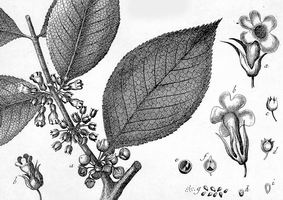
Lamarck, Encycl. 1: t. 524 (1797)
Full name and orig. publication: Besleria [Plum. ex] L., Sp. pl. 2: 619 (1 May 1753).
Etymology: Named after Basilius Besler (1561-1629), a German botanist, pharmacist, horticulturist and publisher, well known for his book „Hortus Eystettensis“, which is one of the greatest jewels of botanical literature.
Synonyms: Eriphia P.Browne (1756), Hematophyla Raf. (1838), Cyrtanthemum Oerst. (1858), Gasteranthopsis Oerst. (1858), Parabesleria Oerst. (1858), Pseudobesleria Oerst. (1858), Pterobesleria C.V.Morton (1953).
Infrafamilial position: Gesnerioid Gesneriaceae (Gesnerioideae) - Beslerieae.
Description: Perennial herbs, shrubs or small trees (to 5 m), with fibrous roots. Stem terete or quadrangular. Leaves opposite, membranous to coriaceous. Inflorescences axillary, ebracteate, fasciculate or subumbellate cymes, rarely flowers solitary. Sepals connate at least at the base, calyx thus campanulate, urceolate or cyclindric, lobes imbricate, rounded or acuminate, entire to serrulate. Corolla yellow, orange, red, or white; tube usually cylindric, sometimes spurred or gibbous at base, or ventricose and contracted at the throat; limb (sub)regular or bilabiate. Stamens 4, didynamous; filaments broad, flattened, adnate to base of corolla tube; anthers coherent at first, becoming free; locules confluent at apex. Nectary annular or semi-annular. Ovary superior, stigma stomatomorphic or bilobed. Fruit a fleshy, globose berry; white, red or orange; exocarp thick, or smooth verrucose, pulp consisting of placental tissue.
Chromosome number: 2n = 32.
Species number: Over 200.
Species names (incl. publication and synonyms): See Skog, L.E. & J.K. Boggan. 2005: World checklist of Gesneriaceae: http://persoon.si.edu/Gesneriaceae/Checklist.
Type species: Besleria lutea L.
Distribution: Throughout the neotropics, with centres of diversity in the Andes of Colombia and Ecuador, some taxa endemic in SE Brazil. Most species are endemic with very local distribution.
Ecology: Terrestrial plants growing in lowland and montane forests, often along streams, on river-banks, on wet rocks etc .
Notes: Morton (1939) distinguished four sections within Besleria: (1) sect. Besleria, (2) sect. Rhynchobesleria (Hanst.) Benth. & Hook., (3) sect. Gasteranthus (Benth.) Benth. & Hook., and (4) sect. Neobesleria Morton. The latter two are now united in the genus Gasteranthus. Despite its large size, Besleria is a very natural genus. Anatomical characters (stomata irregularly scattered, vascular trace of petiole in cross section deeply invaginated) and the nature of the fruit (pulp derived from the placentae) are useful to distinguish Besleria species from taxa in the tribe Episcieae that are similar in habit and/or floral characters. Typically, the Besleria flower is tubular, red, orange or yellow. Ornithophily seems to be common.
Selected references: Wiehler, Selbyana 6: 195 (1983); Morton, Contr. U. S. Natl. Herb. 26: 395-474 (1939), rev.; Skog, Ann. Missouri Bot. Gard. 65: 802-821 (1979), reg. rev. (Panama); Skog, Selbyana 7: 94-99 (1982), new sp.; Chautems, Rev. Brasil. Bot. 14: 51-59 (1991), reg. rev. (Cocoa region of Bahia, Brazil); Skog & Steyermark, Novon 1: 211-222 (1991), new sp.; San Martin-Gajardo & al., Biociências (Porto Alegre) 7: 13-24 (1999), hummingbird pollination; Feuillet & Steyermark, Fl. Venezuel. Guayana 5 (1999), reg. rev.; Chautems, in Fl. Fanerogâm. São Paulo, reg. rev (2002); Skog, Monogr. Syst. Bot. Missouri Bot. Gard. 85: 1114-1128 (2001), reg. rev. (Nicaragua).
Bibliography: See Skog, L.E. & J.K. Boggan. 2005. Bibliography of the Gesneriaceae. 2nd edition: http://persoon.si.edu/Gesneriaceae/Bibliography.
Illustrations:
 |
Besleria lutea L., type species
Lamarck, Encycl. 1: t. 524 (1797) |
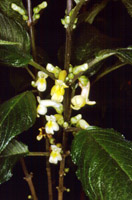 |
Besleria labiosa Hanst. Cult. RBG Edinburgh, phot. A. Weber (2002) |
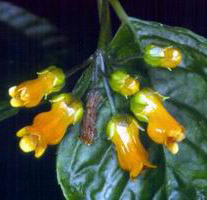 |
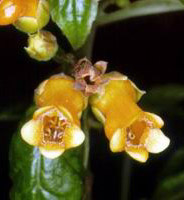 |
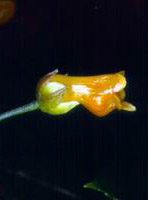 |
Besleria sp.
Cult. RBG Edinburgh, phot. A. Weber (1998) |
last modified: 2007-07-13